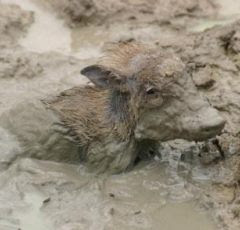 Potatoes lead to peas. After turning the big bed or area and digging in some manure-compost it'd be time to setup the pea trellis. The peas want to be at the north end of whichever bed type they share because they'd block the light of their mates otherwise. My trellis was always fairly funky, just some tall cedar poles driven into the ground in a line a feet apart, a couple others lashed horizonally top and middle, then either netting or chicken wire attached. The end product was a bed dug and ready for the potatoes to go in in a few weeks with a 5-6 ft high trellis along its north edge.
Potatoes lead to peas. After turning the big bed or area and digging in some manure-compost it'd be time to setup the pea trellis. The peas want to be at the north end of whichever bed type they share because they'd block the light of their mates otherwise. My trellis was always fairly funky, just some tall cedar poles driven into the ground in a line a feet apart, a couple others lashed horizonally top and middle, then either netting or chicken wire attached. The end product was a bed dug and ready for the potatoes to go in in a few weeks with a 5-6 ft high trellis along its north edge.After the trellis it's pea planting time. Same general rule applies, plant peas about and inch deep measuring from the op of the pea to the top of the soil. Plant lots of the suckers but try to plant them twice, plant half your seed now and the other half when you plant the potatoes. It's far better to have the peas maturing over a longer period, way more fun for the kids to run out and pick them in a couple months.
West Coast Seeds offers numerous varities of open pollinated seeds probably one or more of your local garden supply stores do now too. Just like potatoes, all beans, garlic, certain peppers and others i'm forgetting, peas, if open pollinated, can be allowed to fully mature on the plant, then dried fully and saved to be replanted year after year. The, and the others, will evolve slowly through the years to your growing conditions. The plants that do best in your conditions will do best on your trellis, you'll naturally save peas from the best plants to save for next year. You the human choser and your growing conditions, your local enviroment, interact to select the best traits for the succeeding generation for your microclimate.
Peas are a legume, legumes have the magic ability to pull out of the air and make it available to other plants growing next to them. So you end up with the peas feeding the potatoes, the peas feeding the humans, and the seed saving circle doing its little bit to undermine the corporate food paradigm. Peas and potatoes, if you could grow beer it'd be a balanced diet.


